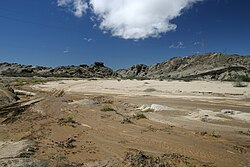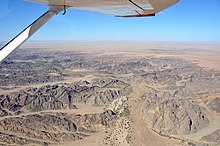
Back Swakoprivier Afrikaans سواکوپ چایی AZB Свакоп Bulgarian Swakop CEB Свакоп CV Swakop German Σβάκοπ Greek Swakop Esperanto Río Swakop Spanish رود سواکوپ Persian
| Swakop | |
|---|---|
 The landscape of the Swakop River Valley near Richthofen | |
| Native name | Tsoaxaub (Khoekhoe) |
| Location | |
| Country | Namibia |
| Regions | Khomas, Otjozondjupa, Erongo |
| Physical characteristics | |
| Source | Eros Mountains near Otjozondjati |
| • elevation | 1,560 m (5,120 ft) |
| Mouth | |
• location | Atlantic Ocean |
• coordinates | 22°40′S 14°32′E / 22.667°S 14.533°E |
• elevation | 0 m (0 ft) |
| Length | 460 km (290 mi) |
| Basin size | 30,100 km2 (11,600 sq mi) |
| Basin features | |
| Tributaries | |
| • left | Otjiseva River, Kaan River, Tsaobis River |
| • right | Sney River, Omusema River, Gami Kaub River, Khan River |
| Waterbodies | Von Bach Dam, Swakoppoort Dam |



The Swakop River (Khoekhoe: Tsoaxaub)[1] is a major river in western central Namibia. Its source is in the Khomas Highland. From there it flows westwards through the town of Okahandja, the historic mission station at Gross Barmen, and the settlement of Otjimbingwe. It then crosses the Namib desert and reaches the Atlantic Ocean at Swakopmund (German: Mouth of the Swakop). The Swakop is an ephemeral river; its run-off is roughly 40 million cubic metres per annum.[2]
The Swakop River, along with its main tributary Khan, is one of the largest temporary water-bearing rivers in the dry western part of Namibia. It is 460 km (290 mi) long and has a 30,100 km2 (11,600 sq mi) large catchment area (including its tributaries).[3] The name comes from the Khoekhoe phrase Tsoa-xaub, from tsoa 'anus‘ and xaub 'excrement'. The name derives from the observation of the flow of large amounts of brownish sludge that discharge into the Atlantic Ocean with the rains.[4]
The area around the river mouth and the surrounding dunes are also known for rich bird life and some unusual plant species (like the Welwitschia) that use the regular fog drifting in from the sea to sustain themselves in the absence of other moisture.
Groundwater levels in the area have dropped about 0.3 m further due to the presence of two big dams built on the Swakop River.[5]
Notwithstanding the river’s irregular flow, some agriculture is undertaken in the Swakop River valley. Thus, the region is well known for its fresh produce, especially tomatoes, asparagus and olives. There are some fears of salt and uranium (possibly natural, possibly from the Rössing uranium mine) endangering this farming industry.[5][6]
- ^ Malan, Johan S (1998). Die Völker Namibias [The Tribes of Namibia] (in German). Windhoek, Göttingen: Klaus Hess. pp. 134–135.
- ^ "Elections 2010: Erongo regional profile". New Era. 24 June 2005.
- ^ Jacobson, Peter J.; Jacobson, Kathryn M.; Seely, Mary K. (1995). Ephemeral rivers and their catchments: Sustaining people and development in western Namibia (PDF 8.7MB). Windhoek: Desert Research Foundation of Namibia. pp. 138–139. ISBN 9991670947.
- ^ Raper, Peter (1987) Dictionary of Southern African Place Names. Johannesburg: Lowry Publishers.
- ^ a b Uranium in groundwater 'not serious': Roessing - The Namibian, Friday 24 June 2005
- ^ "Rössing in the Erongo Region". Rössing Uranium Limited. Archived from the original on 2006-12-30. Retrieved 2007-01-06.
© MMXXIII Rich X Search. We shall prevail. All rights reserved. Rich X Search